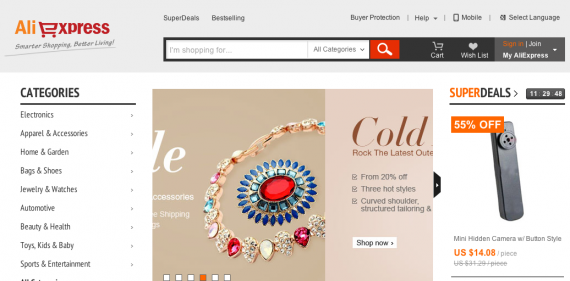The appearance and functionality of an ecommerce site affects its sales. Is the site attractive? Is it easy to navigate? Do core functions work? Is it fast? Does it render well on mobile devices? All of those impact a user of the site. They influence the user’s decision to purchase products, and to return to buy more.
There are many tools to help smaller merchants improve the user experience of their sites. These tools include crowdsourced design services, affordable testing platforms, inexpensive templates, and more. They also include learning from professional user experience designers, folks that direct user experience decisions for a living.
One leading practitioner is Paul Fu, director of user experience at Alibaba.com, the massive business-to-business global marketplace. He leads a team of developers and designers in the U.S. and China that implements changes to Alibaba sites — with 36 million users, 6,000 product categories, and that operate in 240 countries.
Fu has a Ph.D. in Human Factors in Industrial Engineering from Purdue University, and M.S. and B.S. degrees from Tianjin University in China. He is the co-author of the Chinese-language book Human Computer Interaction: User Centered Design.
We recently spoke with Dr. Fu.
Practical Ecommerce: You are director of user experience at Alibaba, which The Economist called the world’s largest ecommerce site. Tell us about Alibaba.
Paul Fu: Alibaba was founded by Jack Ma in 1999. It started as a way for small businesses to list their information online. Today it’s a company with 23 different business units under Alibaba Group. That includes the very popular Taobao, the Chinese consumer-to-consumer marketplace, and Tmall, the Chinese business-to-consumer marketplace. Alibaba.com, the original company, is a business-to-business international trading platform. AliExpress is similar to Alibaba.com, but it allows for smaller-quantity purchases. I am responsible for Alibaba.com and AliExpress.
Alibaba.com connects business buyers and sellers — to source products or find a manufacturer with the right capability to turn an idea into a product. AliExpress is more like a retail website. It helps worldwide buyers purchase products in a retail format.
Alibaba.com has more than 36 million registered users in over 240 countries. We also have 3 million supplier storefronts and almost 6,000 product categories.
PEC: Getting to your job function, what exactly is user experience?
Paul Fu: It consists of four layers. The core is what we call “utility.” Meaning, you have to fulfill certain core user needs. But that’s not enough. We also have “usability,” meaning can a new user learn about your product very quickly and can an experienced user do it efficiently? Then we have “desirability,” which is the look and the feel of the site, so people actually use it and return to use it again. Another layer is “brand experience,” which is utility, usability, and desirability forming the overall brand experience, to create loyalty.
PEC: So user experience consists of utility, usability, desirability, and brand experience. Are those four layers equally important for Alibaba?
Paul Fu: Utility is the most important.
PEC: What are your goals when you design the site?
Paul Fu: If we use the four layers, it will be usable and desirable and with a good brand experience. That’s our design goal. If you put it numerically, there are many ways you can measure that by looking at the user retention rate and repeat users. You can also use surveys and usability studies. The goals also depend on the site and the state of the site. AliExpress is only three years old. It already has an Alexa rating of 146, but it is still trying to grow the sales volume, which is the most important goal.
For the design function, we are going to support that as the first priority: how to grow the sales volume by either increasing the number of visitors that convert into buyers and, also, increasing repeat buyers. That’s the most important aspect. For Alibaba.com, the site is more mature; the goal is in transition itself. Initially, Alibaba was an information platform. But we want to change it into a work platform, so buyers and the sellers can work on Alibaba.com to finish their sourcing process. That’s what the design is going to support.
PEC: Let’s assume that you implement a change on Alibaba.com to improve a facet of usability. How do you know if it worked or not?
Paul Fu: We have different ways to measure that. We have our website tracking data. Also we do regular user surveys. We send out a survey, asking users if they are satisfied with the website and their experience and do they recommend the website to their friends and colleagues. From that, we can track what’s happening.
For specific projects, we also do regular usability studies and visits, meaning sometimes we bring users into our office. We ask them to use the product. We test if they understand the product. Then sometimes we also visit users’ homes to find out how they are using our website in their homes or workplaces. From that, we can understand if they understand the product, or have a problem with the product.
PEC: Walk us through the process of making a design change on Alibaba.com, please. Take us from the start of a new idea until it’s actually deployed.
Paul Fu: When we have a new idea or a request from the project managers, we typically go through a review process first to determine if the project is going to have a major impact or not. Sometimes, for a small project, we might just change the site and go live with an A/B test and then that’s it, it is released to the site. But a project that involves a lot of user changes, we will typically first try to understand what we’re trying to achieve from a business perspective. That’s the first phase.
The second phase is the design. Typically, after we understand the problem we will come up with a design concept that could be illustrated in a wireframe or just in Photoshop. Then we engage our users and bring them into our design process to test if they understand the concept, if there is a problem or not. Then based on the results of these findings we will improve it. We will go back to improve the design and change the prototype and do another round of evaluation.
This design process requires that the product managers, interaction designers, view designers, researchers, content managers, and front-end developers all work very closely together.
After in this stage, if we are happy with the product, we will go to implementation. That’s when we’ll really have the backend written and implemented on the site. We will also go through an A/B test; we will redirect small portion of the traffic to the two different designs, to compare the designs in the live site environment. We’ll look at the user’s adaption rate, if do they understand it, if they are happy. After that, we will pick the best design to take live.
PEC: How many Alibaba employees are involved in that process?
Paul Fu: For Alibaba.com and AliExpress, we have about 500 on the engineering team and about 70 on the user experience team.
PEC: What’s a typical workweek like for you? You have a very responsible job.
Paul Fu: I’m responsible for the international site design. I have both a U.S. and a China team. The China team is much larger. My responsibility includes the team management and budgeting. I’m also very involved in some of the user research — i.e., user visits. That’s a very important aspect to know the user directly.
Another part of my job responsibility is being a user experience advocate, internally and externally.
PEC: Do you travel a lot?
Paul Fu: Yes, I do because I manage an international team. Most of the team members are in Hangzhou, China. So I travel quite frequently back and forth between the U.S. and Hangzhou and also do a lot of remote work. In a typical day, I will work in the U.S. office with pretty flexible hours. At night, I’ll also be online and work with the China team.
PEC: Anything else?
Paul Fu: Two things are very important for smaller, U.S. merchants. First, you cannot be satisfied with just the local economy. There are tools to enable people to do businesses internationally. The world has become smaller and smaller.
The second point is the importance of mobile. This is a very fast growing trend on our platform, the use of mobile devices. For many people, the first web experience they have is not on a PC. It’s on a mobile device.








